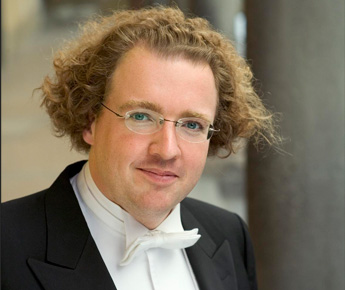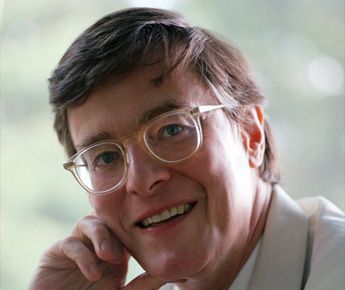Concert Review: Peter Serkin/BSO/Stéphane Denève
Perhaps most remarkably, BSO conductor Stéphane Denève managed to create an atmosphere in which the Symphony Hall audience, which at this time of year sometimes sounds like it’s made up of inpatients from a tuberculosis ward, was utterly captivated: even the quietest moments were accompanied by a welcomed, attentive silence.
By Jonathan Blumhofer

Conductor Stéphane Denève — he brought out incisive, energetic playing from the Boston Symphony Orchestra
Dreams and shadows, light and shade, and a whole range of expression –- from the innocence of childhood to the very adult terrors of totalitarian dictatorship (with a musical mid-life crisis or two thrown in to boot) –- were on full display this weekend at Symphony Hall, as the Boston Symphony Orchestra (BSO) and guest conductor Stéphane Denève presented an enticing program of pieces by Ravel, Stravinsky, and Shostakovich.
For Mr. Denève, this weekend’s performances constituted his scheduled Symphony Hall debut (as opposed to unscheduled: he substituted for an indisposed Sir Colin Davis on short notice last season). As with the invigorating performances heard last week under guest conductor Jaap van Zweden, the BSO seems to have found another kindred spirit in Mr. Denève, who brought out incisive, energetic playing from the Orchestra while presenting a fresh take on a sturdy repertoire warhorse (this week, Shostakovich’s Symphony no. 5).
The concert opened with a luminous reading of the suite from Ravel’s Ma Mère l’oye (Mother Goose), a score originally written for piano four hands. In its best performances, this ballet and its suite come across as a series of vivid scenes, a three-dimensional fairytale that unfolds like a dream for the ears and imagination. This was one of those performances.
Ravel was a marvelous orchestrator, a fact that sometimes overshadows the excellence of his music, and Ma Mère l’oye is one of his most delicate creations. Mr. Denève’s sensitive interpretation emphasized the diaphanous qualities of the score while allowing it to unfold naturally and episodically. There were numerous instrumental solos of note, including a beautifully phrased English horn/oboe duet in the Suite’s second movement (“Tom Thumb”); a glittering passage for celesta and harp in the third movement (“Laideronette, Empress of the Pagodas”); and concertmaster Malcolm Lowe’s several evocative turns, most notably in the fourth movement (“Conversations of Beauty and the Beast”). The close of the finale (“The Fairy Garden”) radiated light.
The excellent pianist Peter Serkin then joined the Orchestra for Stravinsky’s acerbic Concerto for Piano and Winds. This Concerto, which Stravinsky wrote at the behest of former BSO music director Serge Koussevitzky (Stravinsky, Koussevitzky, and the BSO presented the American premiere of the piece at Symphony Hall in January 1925), is an early example of the neoclassical idiom Stravinsky later perfected in Oedipus Rex, the Symphony of Psalms, and, most notably, The Rake’s Progress. In the present score, his influences were evidently less Classical than Baroque: both the form and character of this Concerto are strongly informed by the models of Bach and Handel.
If the Ravel was a reverie, the combination of Mr. Serkin and Mr. Denève was a dream team of insightful, energetic musicians offering a probing account of this peculiar piece. After the shimmer of Mother Goose, the Concerto’s opening movement, which begins with just the orchestra of winds, brass, and double basses, took a moment or two to settle: there were a couple of intonation issues and balances weren’t quite right. By the time Mr. Serkin made his first entrance, though, the BSO was in fine form. In the outer movements, the piano is a bit less soloistic than in your typical Classical or Romantic concerto. Still, Mr. Serkin was very present within the bustling textures, adding color and vibrancy to his involved part. The second movement is a beautiful creation –- Stravinsky called it “a slow song” –- and Mr. Serkin brought out its lyrical qualities most memorably and sensitively.
After intermission, Shostakovich’s Symphony no. 5 presented –- to borrow a phrase from the film Armageddon – the dreamscape of a “surrealistic nightmare.” Shostakovich wrote the piece a short seventy-five years ago, as his career and life hung in the balance after the belatedly scandalous reception of his opera Lady Macbeth of the Mtsensk District. In his own words, the Symphony was “a Soviet artist’s creative reply to just criticism,” though performers, critics, and audiences have found much more sophisticated and subversive messages encoded within it ever since. Regardless, since its premiere in Leningrad in November 1937, the Symphony no. 5 has established itself both as Shostakovich’s most performed symphony, and as the most widely known composition in its genre of the 20th century.
Formally, the Symphony is cast in a rather curious layout: there are two big movements (the first and third) that carry the expressive weight of the music. These are framed by two lesser movements: a bitterly ironic second movement, and an enigmatic, militaristic finale.
On Saturday evening, Mr. Denève was most successful with the first three movements. The opening one breathed fire and concentrated energy. I wouldn’t have minded a bit more of a controlled acceleration into the snare-drum-and-brass climax, but, otherwise, this was a fearsomely intense reading. Similarly, the up-tempo second movement danced along at its odd gait, a chiaroscuro of skeletons and phantasms alternating in the flickering light. In the third movement, Mr. Denève brought out a breathtaking combination of delicacy and power from the BSO. The movement’s highpoint –- featuring tremolo violins and violas, a high cello melody, and pungent accents from basses and brass –- was gripping, while the earlier trio of harp and two flutes (recapitulated by harp and violins at the movement’s end) was an essay in sensitive musicianship. Perhaps most remarkably, Mr. Denève managed to create an atmosphere in which the Symphony Hall audience, which at this time of year sometimes sounds like it’s made up of inpatients from a tuberculosis ward, was utterly captivated: even the quietest moments were accompanied by a welcomed, attentive silence.
Even in this inspired performance, the fourth and final movement was troublesome, though this wasn’t Mr. Denève’s or the BSO’s fault: Shostakovich wrote a movement whose meaning is intentionally open-ended and on Saturday was striking for its hollow ambiguity. The climaxes, in which the brass and percussion play a central role, were tremendous, while the more delicate sections (mainly featuring strings and winds) featured appropriately vulnerable playing. Mr. Denève tried several tempo manipulations (as he also did in the first movement) some of which worked, others of which (like the acceleration at the very beginning) felt a bit forced.
Overall, though, this was a performance that, for me, rivaled the intensity of Leonard Bernstein’s blistering, Shostakovich-sanctioned recording of this piece with the New York Philharmonic (made, coincidentally, on this very stage at Symphony Hall in September 1959), and I don’t make that comparison lightly.
In the lengthy ovation that followed, it was heartening to see both Mr. Denève energetically applauding the BSO and numerous members of the Orchestra applauding him. As I said last week of Mr. van Zweden, let’s have Mr. Denève back again early and often –- he’s a keeper.

